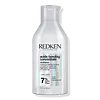What's inside
What's inside
 Key Ingredients
Key Ingredients

 Benefits
Benefits

 Concerns
Concerns

 Ingredients Side-by-side
Ingredients Side-by-side

Water
Skin ConditioningSodium Lauroyl Sarcosinate
CleansingSodium Cocoyl Isethionate
CleansingCocamidopropyl Hydroxysultaine
CleansingGlycol Distearate
EmollientPEG-150 Distearate
EmulsifyingPropanediol
SolventHydroxypropylgluconamide
HumectantHydroxypropylammonium Gluconate
HumectantAspergillus Ferment
Skin ConditioningArginine
MaskingRice Amino Acids
Skin ConditioningPersea Gratissima Oil
Skin ConditioningMauritia Flexuosa Fruit Oil
Skin ConditioningSclerocarya Birrea Seed Oil
HumectantPolyquaternium-10
Hydroxypropyl Guar Hydroxypropyltrimonium Chloride
Tocopherol
AntioxidantTetrasodium Glutamate Diacetate
Parfum
MaskingPhenoxyethanol
PreservativeEthylhexylglycerin
Skin ConditioningCitric Acid
BufferingWater, Sodium Lauroyl Sarcosinate, Sodium Cocoyl Isethionate, Cocamidopropyl Hydroxysultaine, Glycol Distearate, PEG-150 Distearate, Propanediol, Hydroxypropylgluconamide, Hydroxypropylammonium Gluconate, Aspergillus Ferment, Arginine, Rice Amino Acids, Persea Gratissima Oil, Mauritia Flexuosa Fruit Oil, Sclerocarya Birrea Seed Oil, Polyquaternium-10, Hydroxypropyl Guar Hydroxypropyltrimonium Chloride, Tocopherol, Tetrasodium Glutamate Diacetate, Parfum, Phenoxyethanol, Ethylhexylglycerin, Citric Acid
Water
Skin ConditioningDecyl Glucoside
CleansingSodium Cocoyl Isethionate
CleansingCocamidopropyl Betaine
CleansingCitric Acid
BufferingSodium Hydroxide
BufferingPanthenol
Skin ConditioningGlycerin
HumectantDimethicone
EmollientPEG-150 Distearate
EmulsifyingPPG-5-Ceteth-20
EmulsifyingSodium Benzoate
MaskingSodium Chloride
MaskingPEG-55 Propylene Glycol Oleate
Propylene Glycol
HumectantCarbomer
Emulsion StabilisingParfum
MaskingCoco-Caprylate/Caprate
EmollientPolyquaternium-67
Salicylic Acid
MaskingAmodimethicone
Sodium Phytate
Glycol Distearate
EmollientCoco-Betaine
CleansingAcrylates/Beheneth-25 Methacrylate Copolymer
Limonene
PerfumingTrideceth-6
EmulsifyingWater, Decyl Glucoside, Sodium Cocoyl Isethionate, Cocamidopropyl Betaine, Citric Acid, Sodium Hydroxide, Panthenol, Glycerin, Dimethicone, PEG-150 Distearate, PPG-5-Ceteth-20, Sodium Benzoate, Sodium Chloride, PEG-55 Propylene Glycol Oleate, Propylene Glycol, Carbomer, Parfum, Coco-Caprylate/Caprate, Polyquaternium-67, Salicylic Acid, Amodimethicone, Sodium Phytate, Glycol Distearate, Coco-Betaine, Acrylates/Beheneth-25 Methacrylate Copolymer, Limonene, Trideceth-6
 Reviews
Reviews

Ingredients Explained
These ingredients are found in both products.
Ingredients higher up in an ingredient list are typically present in a larger amount.
Citric Acid is an alpha hydroxy acid (AHA) naturally found in citrus fruits like oranges, lemons, and limes.
Like other AHAs, citric acid can exfoliate skin by breaking down the bonds that hold dead skin cells together. This helps reveal smoother and brighter skin underneath.
However, this exfoliating effect only happens at high concentrations (20%) which can be hard to find in cosmetic products.
Due to this, citric acid is usually included in small amounts as a pH adjuster. This helps keep products slightly more acidic and compatible with skin's natural pH.
In skincare formulas, citric acid can:
While it can provide some skin benefits, research shows lactic acid and glycolic acid are generally more effective and less irritating exfoliants.
Most citric acid used in skincare today is made by fermenting sugars (usually from molasses). This synthetic version is identical to the natural citrus form but easier to stabilize and use in formulations.
Read more about some other popular AHA's here:
Learn more about Citric AcidGlycol Distearate serves as a pearlizing or opacifying agent in cosmetic products.
It's often included in cleansers and haircare products to give them a lustrous or shimmering appearance.
It is derived from stearic acid, a natural fatty acid commonly found in vegetable oils and animal fats.
Glycol Distearate isn't fungal acne safe.
Learn more about Glycol DistearateParfum is a catch-all term for an ingredient or more that is used to give a scent to products.
Also called "fragrance", this ingredient can be a blend of hundreds of chemicals or plant oils. This means every product with "fragrance" or "parfum" in the ingredients list is a different mixture.
For instance, Habanolide is a proprietary trade name for a specific aroma chemical. When used as a fragrance ingredient in cosmetics, most aroma chemicals fall under the broad labeling category of “FRAGRANCE” or “PARFUM” according to EU and US regulations.
The term 'parfum' or 'fragrance' is not regulated in many countries. In many cases, it is up to the brand to define this term.
For instance, many brands choose to label themselves as "fragrance-free" because they are not using synthetic fragrances. However, their products may still contain ingredients such as essential oils that are considered a fragrance by INCI standards.
One example is Calendula flower extract. Calendula is an essential oil that still imparts a scent or 'fragrance'.
Depending on the blend, the ingredients in the mixture can cause allergies and sensitivities on the skin. Some ingredients that are known EU allergens include linalool and citronellol.
Parfum can also be used to mask or cover an unpleasant scent.
The bottom line is: not all fragrances/parfum/ingredients are created equally. If you are worried about fragrances, we recommend taking a closer look at an ingredient. And of course, we always recommend speaking with a professional.
Learn more about ParfumPeg-150 Distearate is an emulsifier and thickening agent. It is created from stearic acid.
As an emulsifier, peg-150 distearate helps other ingredients dissolve. This helps prevent ingredient separation.
This ingredient may not be Malassezia folliculitis, or fungal-acne safe.
Learn more about PEG-150 DistearateSodium cocoyl isethionate is a natural ingredient from coconut oil. It is an ultra gentle cleanser that gives a nice foam without drying the skin or impacting the skin barrier.
The amount of foam created depends on the amount of sodium cocoyl isethionate used in the product.
This ingredient also helps improve the spreadability of a product.
Learn more about Sodium Cocoyl IsethionateWater. It's the most common cosmetic ingredient of all. You'll usually see it at the top of ingredient lists, meaning that it makes up the largest part of the product.
So why is it so popular? Water most often acts as a solvent - this means that it helps dissolve other ingredients into the formulation.
You'll also recognize water as that liquid we all need to stay alive. If you see this, drink a glass of water. Stay hydrated!
Learn more about Water